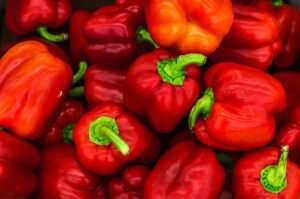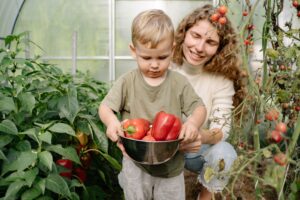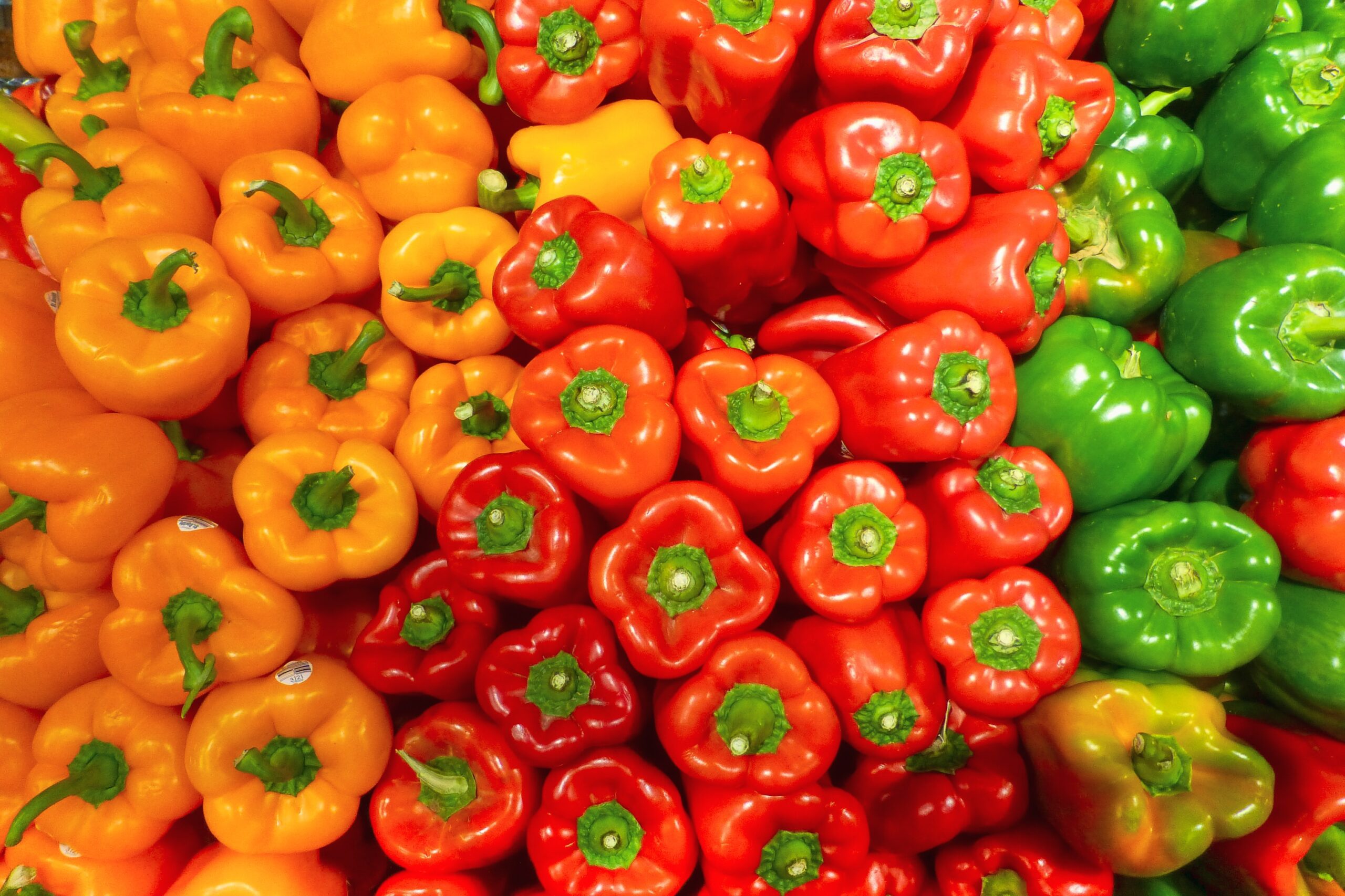Peppers have become a popular ingredient in salads, baked filled with meats or other condiments to adorn the plate. Apart from tomatoes, cucumbers, peppers are very much part of this major three-option product that is grown in greenhouses in South Africa.
Ripe bell peppers are one of the most popular greenhouse crops because the yield and quality can be higher than field-grown crops. It is a slower-growing, more generative crop than other popular greenhouse fruiting crops, like tomatoes, cucumbers, and eggplants. It is important to match a plant’s growth habit, vegetative or generative, to the type of structure in which it will be grown.
Greenhouses fitted with highly technological equipment use a lot of heat and extensive climate control to optimize the growing environment. This type of environment grows peppers as fast as possible for the highest yield and promotes vegetative growth – therefore more generative varieties are used to keep the plants balanced and setting fruit over a very long season. Peppers are pruned to two or four stems and grown up a string trellis to make the best use of vertical space.
Growing peppers on a two-stemmed plant will result in larger peppers than those grown on a four-stemmed plant. Two-stemmed plants will be more resilient under hotter-than-ideal conditions. In simpler greenhouses with less extensive climate control, conditions cannot be optimized as much, and plants are likely to experience heat, cold, and other stresses more often.
Stressful conditions tend to reduce a plant’s vigour, but peppers bred for simpler greenhouses are more vigorous. Good advice is to use field varieties and production techniques, such as a basket-weave trellis or other simple trellis, for production in low-tech greenhouses in short-season areas.
PEPPERS PROPAGATION

Sow pepper seeds in a desired grow medium 6–8 weeks prior to transplanting. Maintain a constant, 27–32°C soil temperature to achieve an ideal germination percentage and uniformity. When the first true leaves show, transplant the seedlings into cell-type containers or blocks. Containers 5cm or larger will produce larger, stronger root systems; 10cm grow blocks are the standard for hydroponics. Grow plants at daytime temperatures of 21–23°C and during night time at 20°C.
Fertilize with a complete nutrient solution (EC 1.5–2, pH 5.2) or equivalent as needed to keep plants dark green and healthy. When transplanting the pepper seedlings into the greenhouse, maintain temperatures of 23°C during the day and 21°C at night during the first week to ensure rapid vegetative growth and root establishment.
PEPPERS FERTILIZING
When growing directly in soil, perform a soil test using the saturated media extract test designed specifically for greenhouse growing, and amend to the recommendations provided. If you are growing a long-term crop that will be in the ground for four months or more you will not be able to provide all the necessary nutrients from pre-planting fertility.
Side dressing or fertigation with extra nutrients will be necessary. Use plant tissue testing to monitor the health of the plants and add extra nutrients when necessary. If growing hydroponically, consult the manufacturer of your nutrients on an appropriate fertility plan for peppers.
TRANSPLANTING or SPACING
To grow two-stemmed plants, use a plant density of 3–3.5 plants (6–7 stems) per square metre. For four-stemmed plants, maintain the same 6–7 stems/square metre spacing, but with half as many plants. One common row spacing to achieve this density is to use a double row of plants, trellised to two parallel overhead wires 60cm apart with walkways 90cm wide.
Each stem is anchored 15cm or so from the next one. Some pepper growers prefer to use four wires with a second set of two more wires 20cm in from the first set of wires because this allows spacing the pepper stems out 30cm from each other on each wire.
CLIMATE
Sweet Peppers are naturally slow-growing and need high temperatures for fast growth. Therefore 7–10 days after transplanting in the greenhouse, lower night temperatures to 17–18°C and maintain a daytime temperature of 23–24°C. Night time temperatures may be increased as high as 19°C if more vegetative growth is required.
Lower night time temperatures promote generative, fruiting growth whereas higher night time temperatures with a flatter temperature profile encourage vegetative, leafy growth. Do not go below 16°C. Peppers have difficulty setting fruit at night time temperatures above 20°C – hence in warm summer nights it is important to get the temperature below that level.
TRELLISING
Onto the overhead wire tie strong twine at the desired spacing and anchor the other end to the base of the plant with a loose knot. Twine made of natural materials tends to degrade and break under greenhouse conditions. If the knot is tight it will cut into the plant as it grows and girdle or even kill the plant, and may form a wound where pathogens can enter.
Twist the stem of the plant around the twine or clip with trellis clips every two weeks to keep it supported and growing up the twine. Make the twine from the wire to the base of the plant fairly taught; peppers will not perform well with a lot of slack in the twine.
PRUNING
Remember; peppers grow as a one-stemmed plant until the first fruit is set, when the plant branches for the first time. Remove the initial pepper that is set in the first split before it develops. This will give the plant time to develop adequate leaf cover to support a fruit load.
It is also recommended to remove the flowers at the second and third nodes, but if all conditions are optimized some growers allow fruit to set after removing just the first one. Every node after the initial split will result in one leaf, one pepper, and two branches.
Field peppers may sometimes form multiple branches per node, but greenhouse peppers are bred to form two even branches. At each node after the initial split, choose the stronger of the two branches to continue forming the stem.
Cut the other branch after it has formed one leaf. This involves cutting off the flower and two other branches at the first node of each lateral branch. This leaves one leaf to develop, called the flag leaf. This leaf will protect the peppers from sunscald and help prevent blossom end rot. Do not prune within 20cm of the tip of the plant. Prune every two weeks, or after about 15cm of growth since the last pruning.
Pepper plants will set 4–5 fruit before aborting the next few flowers. This is normal, for the plant to set fruit in “flushes” and not set every single fruit. Remove fruit if they are deformed or unmarketable to allow the plant to put the energy into setting another fruit further up the plant.
DISEASES AND PESTS
Use crop rotation or change the media to reduce incidence of soil-borne disease. Regularly schedule releases of beneficial insects to control pests. Companies can advise you on the appropriate beneficial organisms based on the timing and square footage of your crops. Minimizing the amount of time with temperatures below 18°C will reduce the amount of botrytis. It is important to have a footbath at the entry and exit to the greenhouse where peppers are grown. Good hygiene practices in any greenhouse should be a stern rule to follow.
HARVEST

Harvest peppers when they are 80% or more of the final ripe color. They will reach full coloration in storage. Using hygienic pruners or a knife cut the fruit off flush with the main stem of the plant. Make sure not to leave a stub on the plant, as this can be an entry point for pathogens. Harvesters should also be dressed and capped with hygienic clothing to avoid any pathogen transferred from another greenhouse or plant.
STORAGE
Peppers can be stored at 7– 8°C in the cold room. Do not store them with ethylene-producing vegetables like tomatoes.
Transferring the boxes with peppers to a market or the cold rooms of a chain store should take place with the least loss of temperature. The more evenly the product is transported in terms of handling and temperature, the longer shelf life it will offer the consumer.
Written by: Nicolene Oosthuizen

